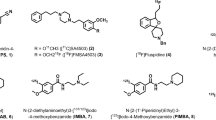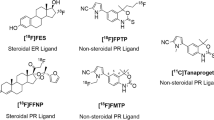Abstract
Objective
4-Benzyl-1-(3-iodobenzylsulfonyl)piperidine, 4-B-IBSP, has shown high-binding affinity to both sigma (σ) receptors in our previous work. In current study, radiolabeling and preclinical evaluation of 4-benzyl-1-(3-[125I]-iodobenzylsulfonyl)piperidine, 4-B-[125I]IBSP, in human ductal breast carcinoma (T47D) cells and in breast adenocarcinoma-bearing BALB/c mice are described.
Methods
Radioiodination of this new σ ligand was performed by a palladium-catalyzed stannylation approach followed by oxidative iododestannylation reaction using Iodo-Gen. Competition-binding assays for binding of 4-B-[125I]IBSP to guinea pig brain membranes and to T47D cells were performed with known σ ligands. The selectivity and binding characteristics (B max and K d) were analyzed. In vitro stability and in vivo blood metabolism studies were also evaluated. Moreover, biodistribution studies were performed in normal and into the tumor-bearing mice at interval time points post-injection (p.i.). Both in vitro and in vivo blockade experiments were done in the presence of the σ receptors blocking agents.
Results
Radioiodinated ligand was obtained in high yield and high specific activity. The σ inhibition constants (K i, nM) for 4-(3-iodobenzyl)-1-(benzylsulfonyl)piperazine (4-IBBSPz), (+)-pentazocine, haloperidol, DTG, and 4-B-IBSP were 1.37 ± 0.19, 3.90 ± 0.77, 2.69 ± 0.33, 30.62 ± 2.01, and 0.61 ± 0.05, respectively. 4-B-[125I]IBSP bound to σ receptor sites preferably to very high-affinity binding sites on T47D cells. The radioligand showed acceptable in vitro and in vivo stabilities in the blood pool. However, in vivo biodistribution studies in normal Swiss albino mice revealed fast clearance of 4-B-[125I]IBSP from blood and the other normal organs. Biodistribution experiments of 4-B-[125I]IBSP in breast adenocarcinoma tumor-bearing BALB/c mice showed a relatively high tumor uptake at 30 min p.i. (4.13 ± 0.95) that reaches to 1.57 ± 0.24 even after 240 min p.i. A pre-injection of 4-B-IBSP and haloperidol with 4-B-[125I]IBSP resulted in 36–57% decrease in activity in the tumor, liver, and brain at 60 min p.i.
Conclusions
The high affinity of 4-B-[125I]IBSP to σ receptor-binding sites, its relatively high uptake, and preferential retention in the tumor as well as an increasing trend observed in the tumor to blood and in the tumor to muscle ratios suggests that an iodine-123 labeled counterpart, 4-B-[123I]IBSP, would be a promising σ radioligand for pursuing further studies to assess its potential for breast tumors imaging with SPECT.







Similar content being viewed by others
References
Ferlay J, Shin H, Bray F, Forman D, Mathers C, Parkin D. GLOBOCAN 2008 v2.0, Cancer Incidence and Mortality Worldwide: IARC Cancer Base No. 10, 2015. http://globocan.iarc.fr. Accessed 10 March 2015
Bénard F, Turcotte É. Imaging in breast cancer: Single-photon computed tomography and positron-emission tomography. Breast Cancer Res. 2005;7:153–62.
Penuelas I, Dominguez-Prado I, Garcia-Velloso MJ, Marti-Climent JM, Rodriguez-Fraile M, Caicedo C, et al. PET tracers for clinical imaging of breast cancer. J Oncol. 2012;2012:1–9.
Palmedo H, Bender H, Grunwald F, Mallmann P, Zamora P, Krebs D, et al. Comparison of fluorine-18 fluorodeoxyglucose positron emission tomography and technetium-99m-methoxyisobutylisonitrile scintimammography in the detection of breast tumours. Eur J Nucl Med. 1997;24:1138–45.
Caveliers V, Everaert H, John CS, Lahoutte T, Bossuyt A. Sigma receptor scintigraphy with N-[2-(1′-piperidinyl)ethyl]-3-[123I]iodo- 4-methoxybenzamide of patients with suspected primary breast cancer: first clinical results. J Nucl Med. 2002;43:1647–9.
Nachar O, Rousseau JA, Ouellet R, Rioux A, Lefebvre B, Ali H, et al. Scintimammography with 11β-Methoxy-(17α,20Z)-[123I]Iodovinylestradiol: a complementary role to [99mTc]Methoxyisobutyl isonitrile in the characterization of breast tumors. J Nucl Med. 2000;41:1324–31.
Martin WR, Eades C, Thompson J, Huppler R, Gilbert P. The effects of morphine- and nalorphine-like drugs in the nondependent and morphine-dependent chronic spinal dog. J Pharmacol Exper Therap. 1976;197:517–32.
Abou-Gharbia M, Ablordeppey SY, Glennon RA. Sigma receptors and their ligands: the sigma enigma. Annu Rep Med Chem. 1993;28:1–10.
Vilner BJ, John CS, Bowen WD. Sigma-1 and sigma-2 receptors are expressed in a wide variety of human and rodent tumor cell lines. Cancer Res. 1995;55:408–13.
Bem WT, Thomas GE, Mamone JY, Homan SM, Levy BK, Johnson FE, et al. Overexpression of sigma receptors in nonneural human tumors. Cancer Res. 1991;51:6558–62.
Aydar E, Palmer CP, Djamgoz MB. Sigma receptors and cancer: possible involvement of ion channels. Cancer Res. 2004;64:5029–35.
Aydar E, Onganer P, Perrett R, Djamgoz MB, Palmer CP. The expression and functional characterization of sigma 1 receptors in breast cancer cell lines. Cancer Lett. 2006;242:245–57.
van Waarde A, Rybczynska AA, Ramakrishnan NK, Ishiwata K, Elsinga PH, Dierckx RA. Sigma receptors in oncology: therapeutic and diagnostic applications of sigma ligands. Curr Pharm Des. 2010;16:3519–37.
van Waarde A, Rybczynska AA, Ramakrishnan NK, Ishiwata K, Elsinga PH, Dierckx RA. Potential applications for sigma receptor ligands in cancer diagnosis and therapy. Biochim Biophys Acta. 2015;1848:2703–14.
Hou C, Tu Z, Robert R, Kung HF, Kung M-P. Characterization of a novel iodinated sigma-2 receptor ligand as a cell proliferation marker. Nucl Med Biol. 2006;33:203–9.
Mach RH, Smith CR, Al-Nabulsi I, Whirrett BR, Childers SR, Wheeler KT. σ2 receptors as potential biomarkers of proliferation in breast cancer. Cancer Res. 1997;57:156–61.
Akhter N, Shiba K, Ogawa K, Kinuya S, Nakajima K, Mori H. In vivo characterization of radioiodinated (+)-2-[4-(4-iodophenyl)piperidino] cyclohexanol as a potential σ-1 receptor imaging agent. Nucl Med Biol. 2007;34:697–702.
John CS, Gulden ME, Li J, Bowen WD, McAfee JG, Thakur ML. Synthesis In vitro binding, and tissue distribution of radioiodinated 2-[125I]N-(N-Benzylpiperidin-4-yl)- 2-Iodo benzamide, 2-[125I]BP: a potential σ receptor marker for human prostate tumors. Nucl Med Biol. 1998;25:189–94.
John CS, Vilner BJ, Bowen WD. Synthesis and Characterization of [125I]-N-(N- Benzylpiperidin-4-yl)-4-iodobenzamide, a new σ receptor radiopharmaceutical: high-affinity binding to MCF-7 breast tumor cells. J Med Chem. 1994;37:1737–9.
John CS, Bowen WD, Fisher SJ, Lim BB, Geyer BC, Vilner BJ, Wahl RL. Synthesis in vitro pharmacologic characterization, and preclinical evaluation of N-[2-(1′- Piperidinyl)ethyl]-3-[125I]Iodo-4-methoxybenzamide (P[125I]MBA) for Imaging Breast Cancer. Nucl Med Biol. 1999;26:377–82.
John CS, Vilner BJ, Gulden ME, Efange SMN, Langason RB, Moody TW, Bowen WD. Synthesis and pharmacological characterization of 4-[125I]-N-(N-Benzylpiperidin- 4-yl)-4-iodobenzamide: a high affinity σ receptor ligand for potential imaging of breast cancer. Cancer Res. 1995;55:3022–7.
John CS, Lim BB, Vilner BJ, Geyer BC, Bowen WD. Substituted halogenated arylsulfonamides: a new class of σ receptor binding tumor imaging agents. J Med Chem. 1998;41:2445–50.
John CS, Gulden ME, Vilner BJ, Bowen WD. Synthesis in vitro validation and in vivo pharmacokinetics of [125I]N-[2-(4-Iodophenyl)Ethyl]-N-Methyl-2-(1-Piperidinyl) ethylamine: A high-affinity ligand for imaging sigma receptor positive tumors. Nucl Med Biol. 1996;23:761–6.
Hirata M, Mori T, Umeda T, Abe T, Yamamoto T, Ohmomo Y. Evaluation of radioiodinated 1-[2-(3,4-dimethoxyphenyl)ethyl]-4-(2-iodophenylpropyl)piperazine as a tumor diagnostic agent with functional sigma receptor imaging by single photon emission computed tomography. Biol Pharm Bull. 2008;31:879–83.
Garner SE, Kung M-P, Foulon C, Chumpradit S, Kung HF. [125I](S)-trans-7-OH- PIPAT: a potential SPECT imaging agent for sigma binding sites. Life Sci. 1994;54:593–603.
Sadeghzadeh M, Sheibani S, Ghandi M, Johari Daha F, Amanlou M, Arjmand M, et al. Synthesis and receptor binding studies of novel 4,4-disubstituted arylalkyl/arylalkylsulfonyl piperazine and piperidine-based derivatives as a new class of σ1 ligands. Eur J Med Chem. 2013;64:488–97.
Council B. Guidelines on the use of living animals in scientific investigations:biological council. London: Institute of Biology; 1987.
Akgӥn E, Portoghese PS, Sajjad M, Nabi HA. Synthesis and 124I-labeling of m-iodophenylpyrrolomorphinan as a potential PET imaging agent for delta opioid (DOP) receptors. J Label Compd Radiopharm. 2007;50:165–70.
Markwell MAK, Fox CF. Surface-specific iodination of membrane proteins of viruses and eucaryotic cells using 1,3,4,6-tetrachloro-3α,6α-diphenylglycoluril. Biochem. 1978;17:4807–17.
Bradford MM. A rapid, sensitive. method for the quantitation of microgram quantities of protein utilizing the principle of protein-dye binding. Anal Biochem. 1976;72:248–54.
Alizadeh AM, Azizian S, Fayazi HR, Mousavi M-S, Nabavi SA. Mouse spontaneous mammary adenocarcinoma as a suitable model of breast cancer in Iran. Basic &. Clin Cancer Res. 2011;3:30–3.
Ablordeppey SY, Fischer JB, Law H, Glennon RA. Probing the proposed phenyl-A region of the sigma-1 receptor. Bioorg Med Chem. 2002;10:2759–65.
Hellewell SB, Bruce A, Feinstein G, Orringer J, Williams W, Bowen WD. Rat liver and kidney contain high densities of sigma-1 and sigma-2 receptors: characterization by ligand binding and photoaffinity labeling. Eur J Pharmacol Mol Pharmacol Sect. 1994;268:9–18.
Sadeghzadeh M, Johari Daha F, Sheibani S, Erfani M. Radioiodination of 4-benzyl-1- (3-iodobenzylsulfonyl)piperidine, 4-(3-iodobenzyl)-1-(benzylsulfonyl)piperazine and their derivatives via isotopic and non-isotopic exchange reactions. J Radioanal Nucl Chem.2014;302, 1119–25.
Mésangeau C, Amata E, Alsharif W, Seminerio MJ, Robson MJ, Matsumoto RR, et al. Synthesis and pharmacological evaluation of indole-based sigma receptor ligands. Eur J Med Chem. 2011;46:5154–61.
Crawford KW, Bowen WD. Sigma-2 receptor agonists activate a novel apoptotic pathway and potentiate antineoplastic drugs in breast tumor cell lines. Cancer Res. 2002;62:313–22.
Wolfe SA Jr, Ha BK, Whitlock BB, Saini P. Differential localization of three distinct binding sites for sigma receptor ligands in rat spleen. J Neuroimmunol. 1997;72:45–58.
Choi S-R, Yang B, Plössl K, Chumpradit S, Wey S-P, Acton PD, Wheeler K, Mach RH, Kung HF. Development of a Tc-99m labeled sigma-2 receptor-specific ligand as a potential breast tumor imaging agent. Nucl Med Biol. 2001;28:657–66.
Acknowledgements
Financial support by Radiation Application Research School of the Nuclear Science and Technology Research Institute is gratefully acknowledged.
Author information
Authors and Affiliations
Corresponding author
Ethics declarations
Conflict of interest
The authors declare that they have no conflict of interest.
Rights and permissions
About this article
Cite this article
Sadeghzadeh, M., Alirezapour, B., Charkhlooie, G.A. et al. Radioiodination and preclinical evaluation of 4-benzyl-1-(3-[125I]-iodobenzylsulfonyl)piperidine as a breast tumor imaging tracer in mouse. Ann Nucl Med 31, 335–346 (2017). https://doi.org/10.1007/s12149-017-1161-8
Received:
Accepted:
Published:
Issue Date:
DOI: https://doi.org/10.1007/s12149-017-1161-8




